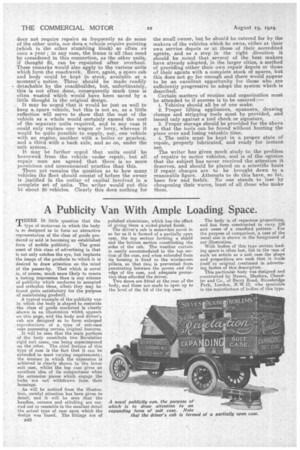A Publicity Van With Ample Loading Space.
Page 22

If you've noticed an error in this article please click here to report it so we can fix it.
rpHERE IS little question that the -L type of motorvan in which the body
is so designed as to form an attractive representation of the class of goods produced or sold is becoming an established form of mobile publicity. The great asset of this class of advertising is that it not only catches the eye, but implants the image of the products to which it is
desired to draw attention on the mind of the passer-by. That which is novel is, of course, much more likely to create a lasting impression than is any scheme of publicity which conforms to accepted and orthodox ideas, albeit they may be found quite satisfactory for the purpose of maintaining goodwill.
A typical example of the publicity van in which the body is shaped to resemble the class of goods marketed is clearly' shown in an illustration whith appears on this page, and the body and driver's cab are designed as to forms enlarged reproductions of a type of suit-case case possessing certain original features. . It will be seen that the main portions of the body constitute two Revelation rigid suit cases' one being superimposed on the other. The chief feature of this type of case is the fact that it can be extended to meet varying requirements; the manner in which the expansion is achieved is clearly shown in the lower suit case, whilst the top case gives an excellent idea of its compactness when the extension pieces which engage the locks are not withdrawn from their housings.
As will be noticed from the illustration, careful attention has been given to detail, and it will be seen that the handles, corners and stitching are carried out to resemble in the smallest detail the actual type of case upon which the design was based. The fittings are of B40 polished aluminium, which has the effect of giving them a nickel-plated finish.
The 'driver's cab is somewhat novel in so far as it is formed of a partially open case, the top section forming a shield and the bottom section constituting the sides of the cab. The weather curtain is neatly accommodated in the top section of the case, and when extended from its housing is fixed to the windscreen pillars, so that rain is prevented from penetrating between the screen and the edge of the case, and adequate protection thus afforded the driver.
Two doors are fitted at the rear of the body, and these are made to open up to the level of the lid of the top case.
The body is of capacious proportions, and has been constructed to carry 120 suit cases of a standard pattern. For the purpose of comparison, a case of the usual size is shown in the foreground of our illustration.
With bodies of this type certain loading space is often lost, but in the ease of inch an article as a snit case the shape and proportions are such that it lends itself to original treatment in advertising, bodies of this description. This particular body was designed and constructed by Messrs. Manhire, Chandler and Co., of Barry Road, Stonebridge Park, London, N.W10, who specialise in the manufacture of bodies of this type.






























